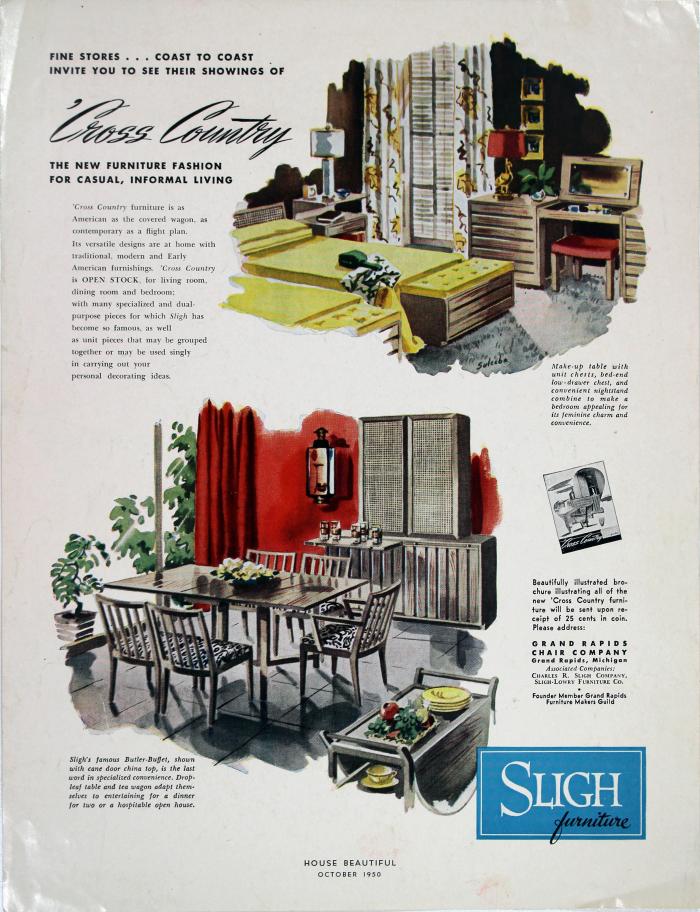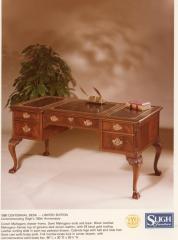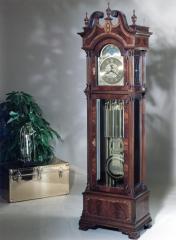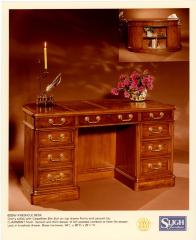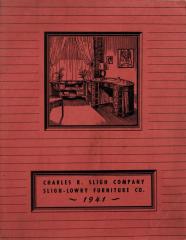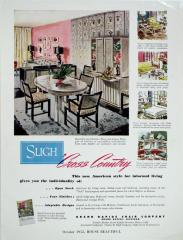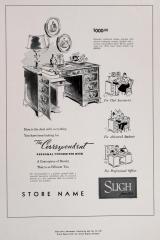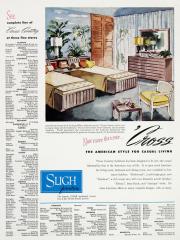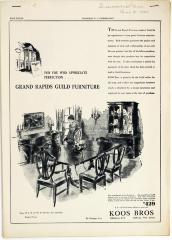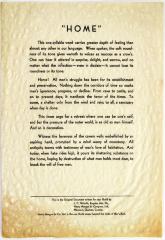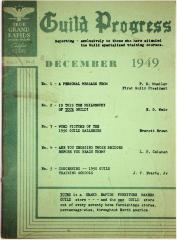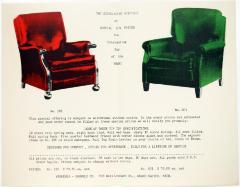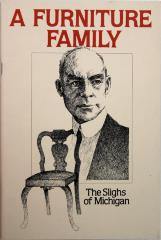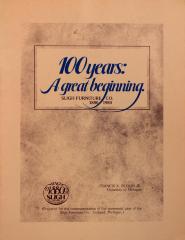Comments and Tags
Be the first to comment on this item!
Advertising
Furniture Industry Archives ➔ Magazine Advertisement, Sligh Furniture Cross Country
Identifier:
1985.16.2eDescription:
Depicts Sligh Furniture advertising that was featured in House Beautiful magazine.Date:
October 1950Materials:
PaperCurrent Location Status:
In StorageCollection Tier:
Tier 2Source:
Gift Of Kesterson, Miriam M.Related Entities:
Sligh Furniture Company (creator)Alternate names: Charles R. Sligh Furniture Company, Sligh – Lowry Furniture Company
Located in Holland, Zeeland, and Grand Rapids, Michigan
COMPANY HISTORY
1880: Charles R. Sligh founds Sligh Furniture Co.
1883 – 1888: Sligh operates Honduras Mahogany Co.
1895 – 1896: Sligh manufactures bicycles alongside furniture
1932: Sligh Furniture Co. liquidates assets and closes its doors.
1933: New Charles R. Sligh Co. founded with assets from Sligh Furniture Co.
1940: Company purchases additional factory in Zeeland, Michigan; name changes to Sligh – Lowry Furniture Co.
1945 – 1962: Sligh – Lowry operates Grand Rapids Chair Co. in Grand Rapids.
1951: Company forms Ply-Curves, Inc.
1953 – ca. 1974: Company operates Sligh – Lowry Contract Furniture Co. subsidiary.
1968: Name changes to Sligh Furniture Co.; Trend Clock Co. becomes a division of Sligh.
1980s: Sligh expanded its business furniture line. The Sligh Corridor group combined classic 18th-century form with 21st-century function and won the first place gold award at NEOCON, the annual business office furniture market.
1990: Rob Sligh became the fourth-generation president. During the 1990s Sligh became the high-end leader in home office furniture.
2000: Home office furniture represented about 40% of the company's sales.
2011: Sligh was sold to Lexington Home Brands in Lexington, North Carolina.
PERSONNEL
Charles R. Sligh founded the company in 1880, after working for Berkey & Gay as a finisher and traveling salesman in 1874. In 1883 Charles R. Sligh traveled to Central America and established the Honduras Mahogany Co., which purchased mahogany timber in Honduras, cut it in New Orleans, and shipped it to Grand Rapids. After the economic crisis depression of 1893, Sligh diversified his manufacturing interests into bicycles as well as furniture. The bicycle operation was merged in 1896 with another manufacturer from Ohio to form the Hamilton-Kenwood Cycle Co. Beginning in 1903 Sligh formed other lumber companies, including the Charles Sligh Timber Co., the Clark-Sligh Timber Co., and the Grand Rapids Timber Com., which invested in timberlands in the U.S. Northwest. These separate companies lasted until the late 1940s. Sligh was a founding member of the Furniture Manufacturers Association of Grand Rapids and was elected to the state senate in 1924. He remained active as president of the company until his death in 1927. Upon the death of the company’s founder, his son-in-law Norman McClave who had been active in the company since 1907, became president, and Charles R. Sligh, Jr. became treasurer. O.W. Lowry became an active voice in cutting production costs after 1929, in an attempt to keep the company solvent after the stock market crash. Frenchman Rene Guenaux came to Sligh as a designer in 1912 and continued through the 1910s.
The Charles R. Sligh Co. was started by Charles R. Sligh Jr. and O.W. Lowry, both former executives of the huge Sligh Furniture Co., which closed in 1933. Charles R. Sligh’s experience as a traveling salesman and treasurer with that company complemented Lowry’s knowledge of engineering and production efficiency. Their new company was opened in the former Thompson Manufacturing plant in Holland, Michigan with only 45 employees, in a deliberate attempt to operate a smaller, leaner company than their 1,500-employee predecessor. Charles R. Sligh Jr. served as president of the Grand Rapids Furniture Manufacturers Association in the 1940s, and the Grand Rapids Furniture Makers Guild and the National Association of Manufacturers in the 1950s. Charles R. Sligh III joined the company’s sales force in 1948 and was followed by his brother Robert L. Sligh in 1954. When Charles Sligh Jr. moved to New York in 1957 to run the National Association of Manufacturers, O.W. Lowry assumed the role of president. In 1968 Lowry retired from the business and members of the Sligh family purchased his interest in the company. Other family members continued the tradition of service to the industry. Robert L. Sligh also served in the 1970s as president of the National Manufacturers Association, and as a board member of the National Association of Manufacturers. Robert L. “Rob” Sligh, Jr. joined the company in 1983 and was made its president in 1990. Like his father and grandfather, Rob was elected president of the Grand Rapids Area Furniture Manufacturers Association in 1995.
PRODUCTS
The company’s first products were inexpensive, asymmetrical walnut bureaus with mirrors. In 1882 Sligh introduced matched bedroom suites. Sligh also made chiffoniers, wardrobes, dressers, and other bedroom occasional pieces in maple, curly birch, mahogany, and oak. Sligh bedroom suites were owned by presidents Rutherford B. Hayes and Benjamin Harrison. Sligh began making a line of case goods from Circassian walnut in 1900, and by 1908 the popular line had become a top seller. Though never considered an “Arts and Crafts” producer, Sligh made at least one notable suite in that style. In 1907 Sligh produced a solid gumwood bedroom suite designed by John E. Brower, with a striking contrasting finish of amber and malachite green. Its functional design was completely unornamented except for circular and oval lily-of-the valley drawer pulls, and delicate lily cut-outs on the bed. The pieces’ gently rounded lines seem more akin to the Moderne movement of the late 1920s than to the other French and Colonial-influenced furniture made by Sligh in 1907. During World War I, Sligh Furniture Co. made walnut gun stocks for the military. By the mid-1920s Sligh billed itself as the “largest manufacturer of furniture exclusively for the bedroom in the world.” From the 1910s through the mid-1920s it offered more than 80 different bedroom suites and 11 dining room suites, in a wide range of period revival styles including Sheraton, Louis XVI, Jacobean, Italian Renaissance, Austrian Baroque, and Dutch 17th Century. Several of the suites also featured an enameled or painted finish, with hand-painted decoration.
Charles R. Sligh Company's first orders came from a former Sligh Furniture Co. client, Macy’s in New York, for the “Salem” bedroom suite, a line formerly produced by Sligh furniture Co. It also manufactured a new line of inexpensive 7-drawer kneehole desks, which proved more popular with Depression-era buyers than the high-end bedroom furniture. This marked a long-term shift in production from the old company’s reliance on bedroom suites to the new company’s desks. In 1937 a prototype known as the “Aqua Vitae” or “Fishbowl” desk drew considerable attention at Market. It featured fashionable Art Deco styling in an oval shape, with burl veneers, a frieze of mirrored glass, built-in radio, a hidden bar, and an aquarium on either end! Unfortunately only the market samples were produced. By 1940 a number of larger kneehole desks as well as coffee and occasional tables, and a commode that concealed a fireproof safe, had been added to the company’s offerings; the bedroom suites were discontinued.
During World War II the plant converted to wartime production of parts for gliders, mortar shell boxes, and cargo trailer bodies, as well as nurses’ dressers and file cabinets. Due to the restriction of wood for civilian manufacturing during the war, timberland near Holland, Michigan was purchased and used to continue furniture production. At the end of the war Sligh – Lowry purchased the Grand Rapids Chair Com., to expand the line of case goods beyond desks. Some lines, especially the “High-Lo Table” and the “Cross Country Line” continued to be produced under the Grand Rapids Chair Co. name. The Holland and Zeeland plants produced a series of high-end, traditional desks known as the “Nottingham Group”. In the 1960s, desks with hand-decorated and lacquered finishes became popular, alongside patterns in production since the Depression. Traditionally styled desks for homes and offices, made from hardwood solids and veneers, remain a major portion of production today. Beginning in the 1970s, freelance designer David Warren added bookcases and credenzas to the offerings of office furniture for the office. In 1989 Sligh introduced a new line of wooden executive office furniture, with 18th-century styling, called “The Corridor Group”.
In 1980, a special Chippendale mahogany Sligh Centennial Desk and Trend 100 Centennial Clock were created, each in limited editions of 1,880, to commemorate the 100th anniversary of the founding of the original Sligh Furniture Co.
OTHER SOURCES
A collection of Sligh family papers is part of the Michigan Historical Collections of the University of Michigan. Bulletin #29 of the Michigan Historical Collections, entitled A Furniture Family: The Slighs of Michigan, was written by Francis Blouin and Thomas E. Powers and published in 1980. Another illustrated history by Blouin, entitled 100 Years: A Great Beginning. Sligh Furniture Co. 1880 – 1980, was published by the Sligh Furniture Co. in 1979.
MARKS AND LABELS
From the 1910s through the early 1930s the trademark was the name “SLIGH” in vertical serif block letters, with the “S” and “H” in a larger size, over “FURNITURE CO.” in small type. It was enclosed in a rectangular outline and often overprinted with “GRAND RAPIDS MICHIGAN”.
During the 1930s the trademark was a shield shape with the face of a Dutch woman wearing a traditional cap, and banners over the shield that read, “FURNITURE” and “by SLIGH”. In the early 1940s, it was changed to a Dutch boy dressed in wooden shoes, resting against a wall. After World War II the company adopted a more contemporary trademark, with the name “SLIGH” in slender letters, enclosed in a box. This same logo was used for the contract line between 1953 and 1974, with the addition of “Contract Furniture” in script under the Sligh name. When Trend Clock Co. was acquired, the mark changed slightly to include the word “Furniture” in script under the word “SLIGH”. A logo with companion styling was designed which read ‘TREND/CLOCKS” in the box, with “by Sligh” in script underneath. In 1980 the company adopted a special circular centennial logo that read, “SINCE 1880 SLIGH 100TH ANNIVERSARY”. By the late 1980s, the name had been modified again to “Sligh” in rounded letters with no box. The Trend name was also dropped in favor of “Sligh Clocks”.
Ply-Curves, Inc.
1951 - present
Grand Rapids, Michigan
Manufacturer of molded plywood chairs and curved plywood parts for chairs and kidney desks. Founded by Charles R. Slight Jr. and O.W. Lowry.
Kesterson, Miriam (Suleeba) (donor)
Miriam Suleeba was an illustrator and artist based in Grand Rapids, Michigan. Miriam grew up to be a student of Mathias J. Alten (1871-1938), and later painted as a commercial illustrator under her married name of Kesterson. Grand Rapids Chair Company (creator)
Located in Grand Rapids, Michigan
COMPANY HISTORY
1872: Company founded; incorporated the following year.
1945 – 1957: Company operates as a subsidiary of Sligh-Lowery, but continues to produce furniture under the Grand Rapids Chair name.
1957: Firm is purchased by Baker Furniture Co., but furniture is still produced under the Grand Rapids Chair name.
1973: Factory and assets fully integrated into Baker; furniture no longer made under the Grand Rapids Chair name.
PERSONNEL
The company was founded by a partnership that included local lumber, sawmill, and furniture baron Charles Carter Comstock as president, along with officers Elisha Foote, Henry Fralick, and S. W. Worden. Elisha Foote ascended to the presidency of the company in 1900, followed by Roger Butterfield in 1920. He was succeeded by Elisha’s son F. Stuart Foote, who ran the firm until its sale to Charles R. Sligh, Jr.
Elisha Foote was responsible for bringing John E. Brower, Sr. from New York to Grand Rapids sometime in the 1890s. He served as the company’s chief designer until his death in 1915. His son, John M. Brower, started the Brower Furniture Co. in 1919, to manufacture unfinished chairs for Grand Rapids Chair and its sister company, Imperial.
Brower was succeeded in the 1920s by George Fletcher and Carl Hammarstrom, who designed a full range of historical revival lines. Renowned designer Kem Weber created an Art Deco dining and living room group for Grand Rapids Chair Co. in 1928. Grand Rapids Chair Co. designs between 1945 and 1973 often came from staff designers of its parent companies Sligh and Baker. Herbert Ten Have designed the “Cross Country” line.
PRODUCTS
From its founding until 1880, the company produced chairs and sold surplus logs and lumber. In 1878, they boasted more than 450 styles of chairs. More than 300 boys and girls were employed at the State Reform School in Lansing to cane the seats. In that same year, they began production of upholstery frames for parlor furniture. In 1880 Elisha Foote expanded the styles of furniture made and began manufacturing complete suites. An 1883 article about Grand Rapids Chair Co. mentions that ash is their popular wood for that season, with “carved panels and heavier moldings.” By the late 1880s their product lines had expanded to include medium-grade chamber suites, tables, bookcases, sideboards, and chiffoniers of maple, birch, cherry, and walnut, as well chairs. Ads by the turn of the century stated emphatically that “we make no chairs.”
Early 20th-century ads show both Golden Oak case pieces with serpentine fronts and cabriole legs referencing French historical styles, as well as Mission oak pieces. A 1900 article also lists mahogany, birch, maple, and bird’s-eye maple in their lines. Ads from the 1910s and ‘20s show dining room furniture, living room, and hall furniture, and spinet desks in a wide range of period styles, including Spanish Renaissance, Spanish Gothic, Elizabethan, Jacobean, Georgian, Adam, and Early American. Favored woods were walnut and mahogany. A Tudor line called “Castle Oak” seems to have been a flagship product in the early twenties.
In 1928 Grand Rapids Chair introduced the “Gaylady” Group, which may have been the name for its first modern line by Kem Weber. Its pieces featured the soft lines of French Art Deco, with light and dark contrasting woods and “artistic color treatments.” During the 1950s the company made the “High-Lo Table,” aimed at newly married couples with small apartments. It featured an adjustable height mechanism, which allowed it to transform from cocktail table to card or dining table. The “Cross Country” line was a modular unit ensemble introduced in 1950 and marketed by Sligh. Its Scandinavian Modern styling and flexibility made it particularly suitable for ranch-style homes. The entire factory was eventually devoted to the production of the Cross County line.
MARKS AND LABELS
Beginning sometime in the 1910s or early 1920s, Grand Rapids Chair Co. adopted a logo that was basically a square frame of molding with chamfered corners that surrounded the words “GRAND RAPIDS CHAIR COMPANY/GRAND RAPIDS/MICHIGAN.” These were printed in a distinctive block type, which used triangular shapes for the rounded letters. An elliptical trademark was adopted for the “Dexter” line in the 1940s. The original rectangular logo was updated as a rectangular chiseled plaque in the late 1940s. Kesterson, Miriam (Suleeba) (creator)
Miriam Suleeba was an illustrator and artist based in Grand Rapids, Michigan. Miriam grew up to be a student of Mathias J. Alten (1871-1938), and later painted as a commercial illustrator under her married name of Kesterson.
